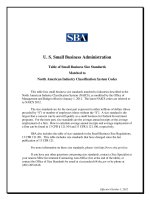U.S. Navy Shipyards - An Evaluation of Workload- and Workforce-Management Practices docx
Bạn đang xem bản rút gọn của tài liệu. Xem và tải ngay bản đầy đủ của tài liệu tại đây (1.58 MB, 188 trang )
This document and trademark(s) contained herein are protected by law as indicated
in a notice appearing later in this work. This electronic representation of RAND
intellectual property is provided for non-commercial use only. Unauthorized
posting of RAND PDFs to a non-RAND Web site is prohibited. RAND PDFs are
protected under copyright law. Permission is required from RAND to reproduce,
or reuse in another form, any of our research documents for commercial use. For
information on reprint and linking permissions, please see RAND Permissions.
Limited Electronic Distribution Rights
Visit RAND at www.rand.org
Explore the RAND National Defense
Research Institute
View document details
For More Information
This PDF document was made available
from www.rand.org as a public service of
the RAND Corporation.
6
Jump down to document
THE ARTS
CHILD POLICY
CIVIL JUSTICE
EDUCATION
ENERGY AND ENVIRONMENT
HEALTH AND HEALTH CARE
INTERNATIONAL AFFAIRS
NATIONAL SECURITY
POPULATION AND AGING
PUBLIC SAFETY
SCIENCE AND TECHNOLOGY
SUBSTANCE ABUSE
TERRORISM AND
HOMELAND SECURITY
TRANSPORTATION AND
INFRASTRUCTURE
WORKFORCE AND WORKPLACE
The RAND Corporation is a nonprofit
research organization providing
objective analysis and effective
solutions that address the challenges
facing the public and private sectors
around the world.
Purchase this document
Browse Books & Publications
Make a charitable contribution
Support RAND
This product is part of the RAND Corporation monograph series.
RAND monographs present major research findings that address the
challenges facing the public and private sectors. All RAND mono-
graphs undergo rigorous peer review to ensure high standards for
research quality and objectivity.
NATIONAL DEFENSE RESEARCH INSTITUTE
Prepared for the United States Navy
Approved for public release; distribution unlimited
U.S. Navy Shipyards
An Evaluation of Workload- and
Workforce-Management Practices
Jessie Riposo, Brien Alkire, John F. Schank,
Mark V. Arena, James G. Kallimani, Irv Blickstein,
Kimberly Curry Hall, Clifford A. Grammich
The RAND Corporation is a nonprofit research organization providing
objective analysis and effective solutions that address the challenges
facing the public and private sectors around the world. RAND’s
publications do not necessarily reflect the opinions of its research clients
and sponsors.
R
®
is a registered trademark.
© Copyright 2008 RAND Corporation
All rights reserved. No part of this book may be reproduced in any
form by any electronic or mechanical means (including photocopying,
recording, or information storage and retrieval) without permission in
writing from RAND.
Published 2008 by the RAND Corporation
1776 Main Street, P.O. Box 2138, Santa Monica, CA 90407-2138
1200 South Hayes Street, Arlington, VA 22202-5050
4570 Fifth Avenue, Suite 600, Pittsburgh, PA 15213-2665
RAND URL:
To order RAND documents or to obtain additional information, contact
Distribution Services: Telephone: (310) 451-7002;
Fax: (310) 451-6915; Email:
Library of Congress Cataloging-in-Publication Data
U.S. Navy shipyards : an evaluation of workload- and workforce-management practices
/ Jessie Riposo [et al.].
p. cm.
Includes bibliographical references.
ISBN 978-0-8330-4569-0 (pbk.)
1. Shipyards—United States—Management. 2. Warships—United States—
Maintenance and repair—Cost effectiveness. 3. United States. Navy—Personnel
management. I. Riposo, Jessie. II. Title: United States Navy shipyards.
VM299.6.U23 2008
623.8'30683—dc22
2008043524
Cover design by Carol Earnest.
The research described in this report was prepared for the United States
Navy. The research was conducted in the RAND National Defense
Research Institute, a federally funded research and development center
sponsored by the Office of the Secretary of Defense, the Joint Staff,
the Unified Combatant Commands, the Department of the Navy,
the Marine Corps, the defense agencies, and the defense Intelligence
Community under Contract W74V8H-06-C-0002.
Cover photo courtesy of Getty Images. Photographed by William Albert Allard.
iii
Preface
e U.S. Navy’s four public shipyards provide depot and other main-
tenance services to the fleet. Managers at the shipyards operate in a
unique environment and have to satisfy many constraints and require-
ments. e shipyards are required to have the flexibility and capac-
ity to support the operational demands of the war-fighter. At times,
un anticipated requirements take priority over regularly scheduled
work. is can result in large disruptions to planned schedules, and
therefore to disruptions in workload, at the shipyards. At the same
time, manage ment decisions are limited by laws and policies that dic-
tate when, where, and by whom maintenance can be performed.
Nevertheless, cost-effective operations and business practices are
of utmost importance: Congress, taxpayers, and competing needs for
limited resources demand them. e Commander, Naval Sea Systems
Command (NAVSEA), asked the RAND Corporation to help iden-
tify and evaluate options for managing the ship-depot industrial base.
Specifically, NAVSEA asked RAND to evaluate cost-effective
workforce-management strategies, alternative workload allocations,
and the relevant best practices of other, comparable organizations. is
research was conducted over a period of one year, beginning in Octo-
ber 2006. It should be of interest to persons concerned with shipyard
management, depot maintenance, and budgeting.
is research was sponsored by the U.S. Navy and conducted
within the Acquisition and Technology Policy Center of the RAND
National Defense Research Institute, a federally funded research and
development center sponsored by the Office of the Secretary of Defense,
iv U.S. Navy Shipyards
the Joint Staff, the Unified Combatant Commands, the Department
of the Navy, the Marine Corps, the defense agencies, and the defense
Intelligence Community.
For more information on this research, write to the principal
author of this report, Jessie Riposo, at For more
information on RAND’s Acquisition and Technology Policy Center,
contact the Director, Philip Antón. He can be reached by e-mail at
; by phone at 310-393-0411, extension 7798;
or by mail at the RAND Corporation, 1776 Main Street, P.O. Box
2138, Santa Monica, California 90407-2138. More information about
RAND is available at www.rand.org.
v
Contents
Preface iii
Figures
ix
Tables
xi
Summary
xiii
Acknowledgments
xxi
Abbreviations
xxiii
CHAPTER ONE
Introduction 1
Depot Maintenance of Naval Ships Is Big Business
1
Overview of the Four Public Shipyards and Other Repair Facilities
4
Norfolk Naval Shipyard
6
Pearl Harbor Naval Shipyard and Intermediate Maintenance Facility
7
Portsmouth Naval Shipyard
8
Puget Sound Naval Shipyard and Intermediate Maintenance Facility
9
Other Facilities
11
Management of the Public Shipyards
13
Objective of the Research
15
Research Approach
15
Organization of the Monograph
16
CHAPTER TWO
An Evaluation of Planned and Actual Workload Demand 17
Shipyard Workload Plans
17
Factors Influencing the Demand for Depot-Level Services
19
Force Structure
19
vi U.S. Navy Shipyards
Maintenance Policies, Practices and Philosophies 21
Maintenance Requirements
22
Other Considerations
23
Workload-Demand Forecasts
24
Variability and Uncertainty in Planned and Actual Demand
27
Summary
32
CHAPTER THREE
Cost-Effective Workforce Strategies 35
Workforce Planning at the Public Depots
36
e Shipyard Workforce and Workforce-Planning Process
36
Workforce-Management Strategies for Meeting Variability and
Uncertainty
38
Analytical Framework and Methodology
45
e Workforce Allocation Tool
47
Data on Workload Demand
49
Data on Workforce Characteristics
50
Data on Cost Factors
51
Productivity and the Relative Cost of Labor
53
Variation in Productivity with the Use of Overtime
53
e Effect of Worker Type and Experience on Productivity
56
e Relative Productive Cost of Labor
58
Strategies for Meeting Planned Workload Demands
61
Implications of Workload Inflation
63
Findings and Recommendations
68
CHAPTER FOUR
Additional Workforce Considerations and Sensitivity Results 71
Shop-Level Evaluations
72
Workload Variability
73
Overtime
74
Recruiting Challenges
75
Time to Become Productive
76
Attrition
76
Demographics
76
Shop-Level Summary
78
Contents vii
e Limitations of Seasonal and Borrowed Labor and the Implications
of Off-Site Work
79
e Implications of Productivity Assumptions
80
e Sensitivity of Available Workforce and Total Cost to Overtime
Productivity
80
Increased Productivity for Borrowed Workers
82
CHAPTER FIVE
An Evaluation of Alternative Workload Allocation Strategies 85
Shift Work from the Private Sector to the Public Sector
87
A Systemic Shift
87
Short-Term Shift
93
Shift Work Between Public Shipyards
95
Summary
96
CHAPTER SIX
An Evaluation of Other Organizations’ Workload- and
Workforce-Management Practices
97
United Kingdom Dockyards
98
Workload-Management Strategies
98
Workforce-Management Strategies
99
European Commercial Shipbuilders
100
Workload-Management Strategies
100
Workforce-Management Strategies
101
e Depots of Other U.S. Military Services
101
U.S. Army Depots
102
U.S. Army Depot Workload-Management Strategies
103
U.S. Army Depot Workforce-Management Strategies
104
NASA Space-Shuttle Maintenance
105
Findings Relevant to the U.S. Navy
108
Retain Core Capabilities and Competencies, Subcontract Others
108
Avoid Excess Overtime
108
Use Temporary Labor to Meet Infrequent Peak Demands
109
Promote a Multiskilled Workforce
109
Smooth Workload Demands
110
Augment Work
110
Track Performance
111
viii U.S. Navy Shipyards
CHAPTER SEVEN
Conclusions and Implications 113
APPENDIXES
A. Depot Laws and Policies Governing Management Options 119
B. Depot Maintenance Industrial Base Study Questionnaire
127
C. Mathematical Details of the Workforce Allocation Tool
143
References
157
ix
Figures
1.1. Average Annual Workload, 2007–2013 5
1.2. Norfolk Naval Shipyard
6
1.3. Pearl Harbor Naval Shipyard and IMF
8
1.4. Portsmouth Naval Shipyard
9
1.5. Puget Sound Naval Shipyard and IMF
10
2.1. Force Levels by Class of Ship, 2007–2036
20
2.2. Total Depot Shipyard Workload
25
2.3. Monthly Shipyard Workload at NNSY, PHSNY,
PNSY, and PSNSY
26
2.4. Annual Deviation Between Workload Estimates and
Actual Workload by Time Prior to Execution
28
2.5. Mean WARR Underestimation of Actual Workload at
Mission-Funded Shipyards
30
2.6. Historical Percent Overtime Worked and Budgeted
at NNSY
31
2.7. e Difference Between Shipyard and PB
Workload Estimates and Between Shipyard and
CP Workload Estimates
32
3.1. Expected Total Workload and Workforce at Public Depots,
FY 2007–FY 2013
41
3.2. Expected Total Workload and Workforce at NNSY,
FY 2007–FY 2013
43
3.3. Expected Total Workload and Workforce at PNSY & IMF,
FY 2007–FY 2013
44
3.4. Expected Total Workload and Workforce at PHNSY,
FY 2007–FY 2013
45
3.5. Expected Total Workload and Workforce at PSNSY & IMF,
FY 2007–FY 2013
46
x U.S. Navy Shipyards
3.6. Analytical Framework for Identifying
Workforce-Management Strategies
47
3.7. Relative Cost Difference Compared to
Permanent Journeymen
52
3.8. Average Productivity Versus Percentage of Overtime for
Four Weeks of Overtime
55
3.9. Productivity by Worker Type and Experience
57
3.10. Cost Premium Compared to Permanent Journeymen
During Straight Time
59
3.11. e Optimized Available Force and the Navy’s Plan Are
Nearly Identical
62
3.12. Estimated Annual Cost Avoidance Offered by the
Optimized Workforce
65
4.1. Age Demographics at NNSY, PHNSY, PNSY, and PSNSY
77
4.3. Optimized Available Workforce Levels for Lower,
Baseline, and Higher Productivity Penalties
81
4.4. e Cost Premium Associated with Using Borrowed
Workers Instead of Permanent Journeymen
83
4.5. Cost-Optimal Levels of Borrowed Labor Assuming
90- and 100-Percent Productivity
84
5.1. Annual Savings Associated with Using Overtime Instead
of New Workers to Manage a 100-Worker Shift in
Demand from the Private Sector to PSNSY
89
5.2. Cumulative Savings Associated with a Shift of 100
Workers from the Private Sector to PSNSY
90
5.3. NPV of Cumulative Savings 20 Years After Shifting
Workload from the Private Sector to PSNSY
91
5.4. NPV of Cumulative Savings 20 Years After Shifting
Workload from the Private Sector to the Public Shipyards
92
5.5. Workload and Workforce at the Public Depots
94
xi
Tables
S.1. Costs of Executing Planned and Increased Workloads xv
1.1. Notional Depot-Level Work Packages for Naval Ships
14
3.1. Average Workforce Composition in FY 2007
41
3.2. Summary of Cost Implications for Executing Planned and
Increased Workloads for the Minimum, Average, and
Maximum Cases
64
3.3. Costs of Executing Planned and Increased Workloads
66
4.1. Workload Variability Among Several Shipyard Shops
74
4.2. Average Overtime and Average Peak Overtime Levels
per Year at Each Shipyard, 1997–2006
75
4.3. Number of Shipyards Exhibiting Each Indicator
78
6.1. Work-Package Magnitude and Duration Across
the Services
102
6.2. Comparability of Maintenance Phases for Commercial
Aircraft, Space Shuttles, and Navy Ships
106
xiii
Summary
e nearly 300 ships of the U.S. Navy are among the most complex
weapon systems operated by the Department of Defense (DoD). e
most demanding maintenance performed on these ships is depot-
level maintenance, which is performed at shipyards that specialize
in the complex repair and upgrade of ship systems, equipment, and
infrastructure.
Depot-level maintenance work of Navy ships is split between
public and private shipyards. e Navy spends about $4 billion
annually on depot maintenance for its ships. is includes about
$3 billion for work performed at four public shipyards: Norfolk and
Portsmouth on the Atlantic, and Puget Sound and Pearl Harbor on the
Pacific. ese public shipyards employ over 25,000 civilians and will
accomplish about 4 million man-days of work in 2008. ey are the
focus of this book.
Several laws and public policies constrain how the Navy can
accomplish depot-level maintenance. Some of these laws and policies
dictate that at least half of all Navy maintenance work be performed
at a public depot (this is known as the 50/50 rule), that the shipyards
maintain some core maintenance capabilities for all of the existing ship
weapon systems, and that depot maintenance be performed in a ship’s
homeport when possible.
e size of this business, the complexities of managing it, and the
need to accomplish work as efficiently as possible led the Commander,
NAVSEA, to research the most cost-effective strategy for matching
workforce supply and demand, alternative workload allocations that
xiv U.S. Navy Shipyards
could improve cost-effectiveness, and what the Navy can learn from
other organizations with similar workload and workforce-management
challenges.
Matching Shipyard Work Supply and Demand
By some measures, the Navy does a reasonable job of matching work-
force supply to workload demand. We compared the Navy’s workforce
plan to an optimized plan for meeting forecast workload demand and
found virtually no difference between the two. In other words, the
Navy’s workforce staffing plan is a cost-effective strategy for meeting
planned workload.
Nevertheless, the Navy’s recent planned workload demands have
not accurately predicted actual workload demands. Rather, workload
forecasts have consistently underestimated actual demands, particu-
larly in longer-term forecasts that are necessary for developing some
of the skills required in shipyard maintenance. Understanding the
causes of this underestimation is an important area of future research.
Although the causes of this underestimation may not be well under-
stood, the shipyards can and do use a variety of means to compensate
for underestimated demand. ese are
Overtime.t A modest level of overtime can in some cases help ship-
yard productivity. It can also allow the shipyards to meet schedule
objectives. In recent years, however, public shipyards have been
using overtime to an extent that diminishes productivity.
Temporary labor.t Temporary labor can theoretically help ease
peak demands, but it requires the availability of a temporary and
otherwise idle labor force. e availability of such a force varies
from shipyard to shipyard. On average, temporary labor is not
quite as productive as permanent labor.
Seasonal labor.t
Seasonal labor can be put on a no-pay status for
up to six months per year. ese workers can then be hired back
into the shipyard when work arrives. is allows shipyard man-
agers to increase and decrease the workforce to meet fluctuations
Summary xv
in workload. However, rehiring seasonal employees is contingent
upon their availability. On average, the cost of seasonal labor is the
same as permanent labor, but productivity is slightly reduced.
Labor borrowed from other shipyards.t Shipyards can and do
borrow from and loan labor to each other. Such labor, however, is
not quite as productive in other shipyards as it is at home. Even if
it were, traveling expenses place a high cost premium on its use.
None of the alternatives the Navy might consider to ease work-
load demands that consistently exceed planned demands is as produc-
tive as resident, permanent labor working standard hours (known as
straight time). An increase in the resident, permanent labor force could
help the Navy be more productive and hedge against the costs of work-
load growth. Table S.1 shows the costs associated with different work-
force and workload scenarios. Under current plans (shown in the first
row of the table), the Navy will have an average annual available force
of 13,800 workers per day and an average demand for 15,485 man-days
per day between 2007 and 2013. e shortfall would be met by over-
time that averages 13 percent of straight time but peaks at 19 percent.
is scenario would cost the Navy $2.8 billion per year.
e second row of the table shows the overtime and cost implica-
tions of a workforce that is not increased to manage a workload that
exceeds the estimate by 6 percent. (Note that this 6-percent growth
rate is higher than the rate seen in recent years.) In this case, the Navy
Table S.1
Costs of Executing Planned and Increased Workloads
Workforce
Increase
Above
Plan?
Workload
Increase
Above
Plan?
Average
Available
Force (men
per day)
Average
Workload
(man-days)
Average
Overtime
Peak
Overtime
Average
Annual
Cost
(FY 2007
$ billions)
No No 13,800 15,485 13% 19% $2.8
No Yes 13,800 16,433 20% 28% $3.2
Yes Yes 14,500 16,433 11% 18% $3.0
Yes No 14,500 15,485 9% 17% $2.8
xvi U.S. Navy Shipyards
has 13,800 workers to accomplish 16,433 man-days of work. Here,
the Navy would use overtime that averages 20 percent of straight time
and peaks at 28 percent. is second scenario would have an average
annual cost of $3.2 billion.
e third and fourth rows show how increasing the available
workforce would hedge against the costs associated with no increase
in the workforce. e third row shows increases in both the workforce
and the workload. Should the Navy increase its workforce by 5 percent
(to 14,500 workers), then workload growth would cost only $3.0 bil-
lion. is is because overtime would average only 11 percent and peak
at no more than 18 percent. In this case, the additional 700 perma-
nent workers reduce the average annual overtime from 20 percent to
11 percent.
Perhaps most importantly, insurance against workload growth
would cost the Navy virtually nothing. As the fourth row of the table
shows, should the shipyard workforce grow above current forecasts but
workload demand not materialize, executing the workload with higher
workforce levels would still cost the Navy only $2.8 billion. is is
because with more workers, the shipyards could use less overtime to
accomplish their current workload.
ese results, of course, depend on several assumptions about
workload growth, use of overtime, and the productivity of different
types of labor. For the highest percentage workload growth evaluated,
16 percent, the cost penalty for not increasing the workforce could
be up to $1.5 billion annually. In this case, the cost of increasing the
workforce if there is no work growth, $200 million per year, is signifi-
cantly less than the cost of not increasing the workforce if there is work
growth. For the highest percentage workload growth evaluated, should
the workload growth be minimal, increasing the workforce to meet the
highest expected workload growth will result in cost savings of approx-
imately $100 million per year. Variations in overtime and productivity
assumptions do not change these general findings.
Summary xvii
Alternative Workload Allocations
Our analyses of how to accomplish shipyard workload most cost-
effectively assume a static workload demand (i.e., workload that is fixed
based on a certain plan). eoretically, the Navy could choose to allo-
cate workload differently than it currently does between public and
private shipyards or among the four public shipyards.
Shifting workload from the public sector to the private sector may
not be realistic for two reasons. First, such a shift may violate federal
law requiring that no more than 50 percent of depot maintenance work
be performed by the private sector. Second, most of the public ship-
yard work involves nuclear vessels; qualifying a third private shipyard
(beyond the two currently doing such work) to work on such systems
would be expensive and politically challenging.
Shifting nonnuclear surface-ship work from the private sector
to the public sector would not result in cost savings for the Navy if
“green” (i.e., unskilled) labor would have to be hired to accomplish
this additional work. If there was readily available skilled labor to per-
form the work, however, the minimum cost savings estimated could
be offset by costs that we were unable to quantify. Potential costs, such
as those associated with increases to indirect expenses at private ship-
yards, contract modifications and associated penalties or fees, reduc-
tion in the competition that is assumed to reduce costs and improve
quality, productivity adjustments between public- and private-sector
shipyards, and investments needed to accomplish surface-combatant
work in the public shipyards, could not be estimated but could result
in increased cost.
Shifting work among the public shipyards might realize some effi-
ciencies, but a full evaluation of this option would require data that
are not currently available. Such a shift would also have to consider
the capabilities of each shipyard, how well shifts could accommodate
certain policies (such as homeport rules), and, of course, the cost-
effectiveness of changes.
xviii U.S. Navy Shipyards
Workload-Management Practices in Other Organizations
To identify practices used elsewhere that may be adapted to the
public shipyards, we identified four organizations whose workforce-
management issues are similar to those of the public shipyards. ese
organizations are the UK dockyards that support the Royal Navy,
European commercial shipbuilders, U.S. Air Force and U.S. Army
depots, and the space-shuttle program of the National Aeronautics and
Space Administration (NASA). None encounters both the complexity
and breadth of work that the U.S. Navy faces in shipyard maintenance,
but some individual characteristics of their work approximate those of
the Navy.
Common practices that these organizations use to manage work-
load, some of which are already used by the Navy to some extent and
others which would be more difficult to adapt, include
Identifying core capabilities and competencies and subcon-t
tracting out the others.
Some public shipyards use contractors
extensively, but others do not have such local support readily
available. Any U.S. Navy subcontracting efforts must stay within
core-capability and 50/50 rules.
Avoiding excess overtime.t As noted above, the U.S. Navy already
relies on what might be considered excessive overtime, and should
consider hiring more shipyard workers to boost productivity and
reduce costs.
Using temporary labor to meet infrequent demands.t As noted
above, some U.S. Navy shipyards may not have a sufficient local
pool from which to draw such labor.
Promoting a multiskilled workforce.t Adopting such a practice
would require union approval and could be limited by the need for
some workers to develop highly specialized skills in some areas.
Smoothing workload demands.t e U.S. Navy’s initiatives in
this area include a Fleet Availability Scheduling Team charged
with keeping shipyard work more level over time and across
shipyards.
Summary xix
Accepting other work.t e U.S. Navy shipyards have under-
taken some outside work, such as work on U.S. Army vehicles.
Tracking performance.t Many methods to track performance
were pioneered in U.S. Navy shipyards.
Altogether, the U.S. Navy appears to have implemented many of
the above strategies when it was relatively easy to do so. Other strate-
gies, such as reducing overtime or using more contracted labor, would
take more work to implement.
Conclusions and Recommendations
Our analysis shows that the Navy workforce plan will efficiently exe-
cute the Navy’s planned workload. We discovered that the Navy uses
practices common in other organizations to manage workload variabil-
ity and uncertainty. Further measures, such as greater levels of subcon-
tracting, could require significant effort to implement.
Nevertheless, given what may be an underestimated future work-
load, additional measures to decrease overtime levels and hedge against
workload growth are worth considering. We found that increasing
the number of permanent journeyman by hiring apprentices is a cost-
effective strategy. At the least, such measures are necessary to curtail
the currently high levels of overtime that the shipyards use to accom-
plish additional unplanned work. Using more workers and less overtime
would cost about the same amount that the Navy currently spends to
execute its workload and would provide a hedge against the costs asso-
ciated with workload inflation or surge requirements.
Beyond increasing the permanent journeyman staff of the ship-
yards, the Navy could shift more work to the private sector through
subcontracts. Although the costs of such a strategy were not evaluated
during our study, we did discover that other organizations extensively
employ subcontractors to avoid excessive overtime. Such measures may
require Congressional action and hence might not be considered fea-
sible in the immediate future.
xxi
Acknowledgments
is research would not have been possible without the contributions
of numerous individuals. First and foremost, the research would not
have been possible without the support and interest of VADM Paul
Sullivan, Commander, NAVSEA; RADM Mark Hugel, Deputy Com-
mander, Logistics, Maintenance and Industrial Operations (NAVSEA
04); and Pat Tamburino, Assistant Deputy Chief of Naval Operations,
Fleet Readiness & Logistics (N4B). In addition to these individuals, we
received support and guidance from Chris Deegan and CAPT Mark
Whitney, both of whom helped get the project underway. Special
thanks are due to Michael C. Sydla of NAVSEA 04, whose persistent
assistance was critical to the success of the project.
is research required extensive interaction with numerous indi-
viduals at the public shipyards. We thank the commanding officers
of each (as of 2006): CAPT Richard D. Berkey of Norfolk Naval
Shipyard (NNSY), CAPT Frank Camelio of Pearl Harbor Naval
Shipyard (PHNSY), CAPT Robert W. Mazzone of Portsmouth
Naval Shipyard (PNSY), and CAPT Daniel J. Peters of Puget Sound
Naval Shipyard (PSNSY). e commanding officers and numerous
staff at each of the shipyards provided valuable insights, data, and
discussions. We especially thank Ken Finlay, Jim Shoemaker, and
Bill Kockler of NNSY; Kevin Brigham, James Culver, Mark Antaya,
and Art Cannon of PNSY; Dennis Fong and Lori Ikeda of PHNSY;
and Tim Morris and Dave Fenton of PSNSY.
Numerous other individuals throughout the NAVSEA organiza-
tion shared their substantial knowledge of the workload-, workforce-,
xxii U.S. Navy Shipyards
and budget-planning processes at the public shipyards. We thank in
particular Sharon Smoot, John James, Steven D. Perkins, and Larry
Marquess of NAVSEA 04.
In addition, we thank individuals at the Fleet Forces Commands
who provided valuable insights about workload planning and work-
load allocation. We thank in particular RADM John Clark Orzalli
and the staff of the Mid-Atlantic Regional Maintenance Center;
William Ryzewic, Deputy Chief of Staff for Pacific Fleet maintenance;
and Glenn Hotel and Steve Hanson of the Chief of Naval Operations,
Fleet Readiness Division.
For assistance rendered during our work on the evaluation of
the management practices of other organizations, we thank Jackie
McArthur of Babcock; Howard Mathers and Commodore I. Jess of the
UK Ministry of Defence Defence Equipment and Support organiza-
tion; Andy Burch and Mike Owen of Devonport Management Lim-
ited; Paul Karas of Fleet Support Limited; Michael Cox of Red River
Army Depot; Gilda Knighton of Anniston Army Depot; and Susan
Rogers of the Army Materiel Command. We thank Eric Clanton of the
United Space Alliance for giving us insight into how NASA maintains
its space-shuttle fleet.
Finally, if it were not for the efforts and contributions of numer-
ous individuals affiliated with RAND, this book would not demon-
strate the detailed, rigorous, and thorough evaluations characteristic of
RAND research. We thank Victoria Hill for her analysis of the work-
load, Jeff Tanner for his analysis of the workforce, Bob Murphy for his
review and consultation, Debbie Peetz for her project support, and Ed
Keating for his valuable suggestions and rigorous review of the draft
of this book.
xxiii
Abbreviations
BRAC Base Realignment and Closure
CFFC Commander, Fleet Forces Command
CFR Code of Federal Regulations
CITE Center of Industrial and Technical Excellence
CMA continuous maintenance availability
CNO Chief of Naval Operations
CP Capability Plan
CSMP Current Ships Maintenance Project
DoD U.S. Department of Defense
DLI direct-labor index
DML Devonport Management Limited
DPIA docking planned incremental availability
DSRA/ERP docking selected restricted availability/extended
refit period
EU European Union
FSL Fleet Support Limited
FTE full-time equivalent









